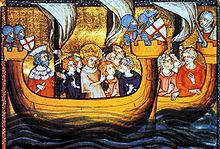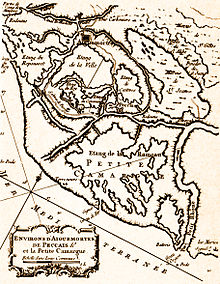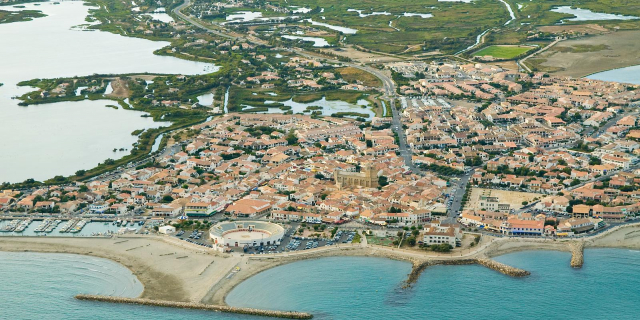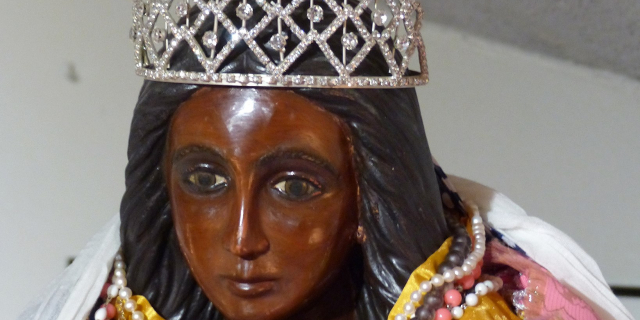Aigues-Mortes (French pronunciation: [ɛɡmɔʁt]; Occitan: Aigas Mòrtas) is a commune in the Gard department in the Occitania region of southern France. The medieval city walls surrounding the city are well preserved. Situated on the junction of the Canal du Rhône à Sète and the Chenal Maritime to Le Grau-du-Roi, the town is a transit center for canal craft and Dutch barges.
The Roman general Gaius Marius is said to have founded Aigues-Mortes around 102 BC, but there is no documentary evidence to support this.
A Roman by the name of Peccius cultivated the first salt marsh and gave his name to the Marsh of Peccais.[1] Salt mining started from the Neolithic period and was continued in the Hellenistic period, but the ancient uses of saline have not resulted in any major archaeological discovery. It is likely that any remains were destroyed by modern saline facilities.[2]
Middle Ages Louis IX on a ship departing from Aigues-Mortes, for the Seventh Crusade
Louis IX on a ship departing from Aigues-Mortes, for the Seventh Crusade Map of Aigues-Mortes and its access to the sea
Map of Aigues-Mortes and its access to the sea Aigues-Mortes Plan
Aigues-Mortes PlanIn 791, Charlemagne erected the Matafère Tower amid the swamps for the safety of fishermen and salt workers. Some argue that the signaling and transmission of news was not foreign to the building of this tower which was designed to give warning in case of arrival of a fleet, as for the Magne Tower at Nîmes.
The purpose of this tower was part of the war plan and spiritual plan which Charlemagne granted at the Benedictine abbey, dedicated to Opus Dei (work of God) and whose incessant chanting, day and night, was to designate the convent as Psalmody or Psalmodi. This monastery still existed in 812, as confirmed by an act of endowment made by the Badila from Nîmes at the abbey.[3]
At that time, the people lived in reed huts and made their living from fishing, hunting, and salt production from several small salt marshes along the sea shore. The region was then under the rule of the monks from the Abbey of Psalmody.
In 1240, Louis IX, who wanted to get rid of the dependency on the Italian maritime republics for transporting troops to the Crusades, focused on the strategic position of his kingdom. At that time, Marseille belonged to his brother Charles of Anjou, King of Naples, Agde to the Count of Toulouse, and Montpellier to the King of Aragon. Louis IX wanted direct access to the Mediterranean Sea. He obtained the town and the surrounding lands by exchange of properties with the monks of the abbey.[4] Residents were exempt from the salt tax which was previously levied so that they could now take the salt unconstrained.[5]
He built a road between the marshes and built the Carbonnière Tower to serve as a watchtower and protect access to the city. Louis IX then built the Constance Tower on the site of the old Matafère Tower, to house the garrison. In 1272, his son and successor, Philip III the Bold, ordered the continuation of the construction of walls to completely encircle the small town. The work would not be completed for another 30 years.
This was the city from which Louis IX twice departed for the Seventh Crusade in 1248 and for the Eighth Crusade in 1270, where he died of dysentery at Tunis.
The year 1270 has been established, mistakenly for many historians, as the last step of a process initiated at the end of the 11th century. The judgment is hasty because the transfer of crusaders or mercenaries from the harbour of Aigues-Mortes continued after this year. The order given in 1275 to Sir Guillaume de Roussillon by Philip III the Bold and Pope Gregory X after the Council of Lyons in 1274 to reinforce Saint-Jean d'Acre in the East shows that maritime activity continued for a ninth crusade which never took place.[6]
There is a popular belief that the sea reached Aigues-Mortes in 1270. In fact, as confirmed by studies of the engineer Charles Leon Dombre, the whole of Aigues-Mortes, including the port itself, was in the Marette pond, the Canal-Viel and Grau Louis, the Canal Viel being the access channel to the sea. The Grau-Louis was approximately at the modern location of La Grande-Motte.
At the beginning of the 14th century, Philip the Fair used the fortified site to incarcerate the Templars. Between 8 and 11 November 1307, forty-five of them were put to the question, found guilty, and held prisoner in the Tower of Constance.[7]
Modern and contemporary periodsAigues-Mortes still retained its privileges granted by the kings.[8] The Protestant Jean d'Harambure "the One-Eyed", light horse commander of King Henry IV and former governor of Vendôme was appointed governor of Aigues-Mortes and the Carbonnière Tower on 4 September 1607. To do this, he took an oath before the Constable of France Henri de Montmorency, Governor of Languedoc, who was a Catholic and supported the rival Adrien de Chanmont, the Lord of Berichère. The conflict continued until 1612, and Harambure, supported by the pastors of Lower Languedoc and the inhabitants, finished it by a personal appeal to the Queen.[9] He eventually resigned on 27 February 1615 in favour of his son Jean d'Harambure, but King Louis XIII restored him for six years. On 27 July 1616 he resigned again in favour of Gaspard III de Coligny, but not without obtaining a token of appreciation for the judges and consuls of the city.
At the beginning of the 15th century, important works were being undertaken to facilitate access to Aigues-Mortes from the sea. The old Grau-Louis, dug for the Crusades, was replaced by the Grau-de-la-Croisette and a port was dug at the base of the Tower of Constance. It lost its importance from 1481 when Provence and Marseille were attached to the kingdom of France. Only the exploitation of the Peccais salt marshes encouraged François I, in 1532, to connect the salt industry of Aigues-Mortes to the sea. This channel, called Grau-Henry, silted up in turn. The opening, in 1752, of the Grau-du-Roi solved the problem for a while. A final solution was found in 1806 by connecting the Aigues-Mortes river port through the Canal du Rhône à Sète.[10]



From 1575 to 1622, Aigues-Mortes was one of the eight safe havens granted to the Protestants. The revocation of the Edict of Nantes in 1685 caused severe repression of Protestantism, which was marked in Languedoc and the Cévennes in the early 18th century by the Camisard War. Like other towers in the town, from 1686 onwards, the Constance Tower was used as a prison for the Huguenots who refused to convert to Roman Catholicism. In 1703, Abraham Mazel, leader of the Camisards, managed to escape with sixteen companions.[citation needed]
During the French Revolution, the city was called Port-Pelletier.[11] At that time the port had almost disappeared due to silting, induced by the intensification of labour in the watershed at the same time as the clearing of woods and forests following the abolition of privileges. The decline of forest cover led to soil erosion and consequently a greater quantity of alluvial deposits in the ports of the region. Thus, in 1804 the prefect "Mr. de Barante père" wrote in a report[12] that: "The coasts of this department are more prone to silting ... The ports of Maguelonne and Aigues Mortes and the old port of Cette no longer exist except in history" he alerted: "An inordinate desire to collect and multiply these forest clearings since 1790 ... Greed has devoured in a few years the resource of the future, the mountains, opened to the plough, show that soon naked and barren rock, each groove becoming a ravine; the topsoil, driven by storms, has been brought into the rivers, and thence into the lower parts, where it serves every day to find the lowest parts and the darkest swamps."
The massacre of Italians (August 1893) Massacre of Italian saltworkers at Aigues-Mortes
Massacre of Italian saltworkers at Aigues-MortesThe Massacre of the Italians at Aigues-Mortes was a series of events on 16 and 17 August 1893 which resulted in the deaths of immigrant Italian workers of the Compagnie des Salins du Midi, at the hands of French villagers and labourers. Estimates range from the official number of eight deaths up to 150, according to the Italian press of the time. The case was also one of the greatest legal scandals of the time, since no convictions were ever made.































Add new comment